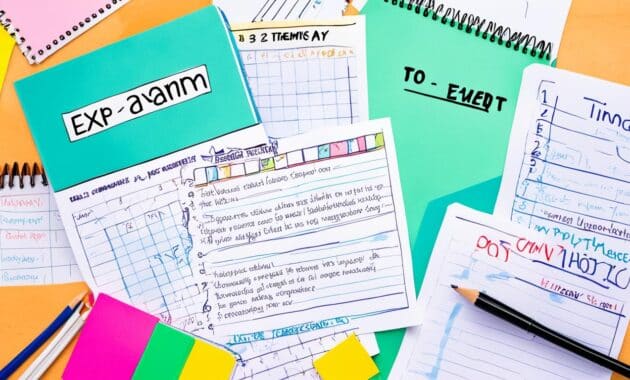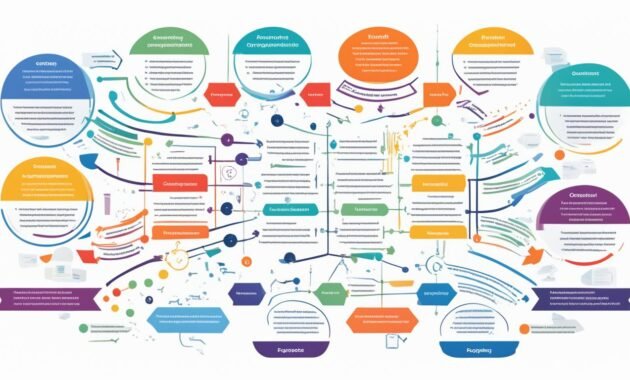Proper organization of exam papers is essential for students to effectively manage their study materials and improve their academic performance. Disorganized papers can lead to confusion, misplaced information, and wasted time searching for essential documents. To avoid these pitfalls and set yourself up for success, it is crucial to master the art of organizing exam papers.
In this section, we will explore various tips, techniques, and strategies for organizing exam papers to ensure smooth preparation and optimal performance in exams. From exam paper organization tips to best practices for effective management, we will uncover the most efficient methods that can help you stay organized and focused throughout your exam journey.
With these insights, you will discover how to arrange exam papers effectively, strategies for sorting exam papers, and efficient exam paper filing techniques. Whether you prefer physical organization methods or digital solutions, we have got you covered. By implementing these tips, you will streamline your study process and navigate through your exam materials with ease.
Key Takeaways:
- Organizing exam papers is crucial for effective study management and improved academic performance.
- Implementing efficient exam paper organization techniques can save time and reduce stress.
- Strategies for sorting and filing exam papers can help you stay organized and focused.
- Choose the organization method that works best for you, whether physical or digital.
- By mastering the art of organizing exam papers, you set yourself up for success in exams.
Understanding the Importance of Exam Organization
Proper organization is a crucial aspect of exam preparation that significantly impacts students’ overall performance. By understanding the importance of exam organization, students can enhance their study techniques and effectively navigate the exam structure and syllabus.
Exam organization encompasses various elements such as exam format, exam structure, exam syllabus, and study materials. These factors play a vital role in determining the level of preparedness and success in exams. When students have a clear understanding of the exam format, they can tailor their study methods accordingly.
An organized approach to studying allows students to prioritize their study materials and allocate their time effectively. By organizing study materials, students can access the required resources easily and review relevant information efficiently.
Moreover, being familiar with the exam structure and syllabus helps students identify the key areas to focus on during their exam preparation. This knowledge aids in prioritizing study topics and allocating study time appropriately.
Additionally, effective study techniques complement exam organization and enhance students’ overall performance. Implementing techniques such as summarizing study materials, practicing past exam papers, and creating effective study schedules can optimize the exam preparation process.
“A well-organized exam preparation allows students to approach exams with confidence and clarity, maximizing their chances of success.”
By embracing proper exam organization, students can streamline their study process, reduce stress, and improve their overall academic performance.
Time Management for Exam Preparation
Effective time management is essential for organizing exam papers and maximizing your study efforts. By implementing practical strategies, you can create a study schedule, prioritize subjects, and allocate time effectively, ensuring productive study sessions and preventing burnout.
Here are some tips to help you manage your time efficiently during exam preparation:
- Create a Study Schedule: Develop a weekly or monthly study schedule that outlines specific time slots for each subject. This will provide structure and help you stay focused.
- Prioritize Subjects: Identify the most critical subjects or topics that require more attention and allocate more study time to them.
- Allocate Time for Different Topics: Break down your study sessions into smaller chunks and assign dedicated time to each topic or subtopic. This approach helps you cover all the necessary material without feeling overwhelmed.
- Incorporate Breaks: Taking regular breaks during study sessions is essential for maintaining focus and preventing mental fatigue. Schedule short breaks between study blocks to recharge and relax.
To visualize the effectiveness of these time management techniques, consider the following table:
| Time Slot | Subject |
|---|---|
| Morning Session | Mathematics |
| Physics | |
| Afternoon Session | English Literature |
| Chemistry |
“Effective time management is the key to organizing exam papers and optimizing study sessions. By creating a study schedule, prioritizing subjects, allocating time for different topics, and taking regular breaks, students can maintain focus and achieve better results.” – Dr. Jane Simmons
Implementing these time management strategies will enable you to make the most of your study sessions, ensure effective organization of exam papers, and enhance your overall exam preparation.
Utilizing Study Techniques for Exam Papers
Adopting effective study techniques can significantly enhance exam paper organization. By incorporating various study methods into your exam preparation, you can optimize your learning and improve your overall performance. Here are some valuable techniques to consider:
1. Practice Past Questions
Practicing past questions is an excellent way to familiarize yourself with the exam format and identify areas that require more focus. By working through previous exam papers, you can gain a better understanding of the types of questions typically asked and develop strategies for answering them effectively.
2. Group Study
Engaging in group study sessions can provide opportunities for collaborative learning and help you gain new perspectives on challenging topics. By discussing and explaining concepts to others, you can reinforce your own understanding while benefiting from different viewpoints and insights.
3. Condense Notes
Condensing your study notes into concise summaries can aid in organization and improve retention. By focusing on the most essential information and creating clear, succinct notes, you can easily review and revise key concepts, saving time and enhancing your understanding of the subject matter.
4. Utilize Study Resources
Take advantage of various study resources such as online platforms, mobile apps, and virtual classes. These resources often provide additional materials, practice quizzes, interactive learning tools, and expert guidance that can supplement your exam preparation and help you grasp difficult concepts more effectively.
| Study Technique | Benefits |
|---|---|
| Practice past questions | Enhances familiarity with the exam format and improves problem-solving skills. |
| Group study | Promotes collaborative learning, diverse perspectives, and deeper understanding. |
| Condense notes | Facilitates organization, revision, and retention of key information. |
| Utilize study resources | Access to supplementary materials, interactive tools, and expert guidance. |
5. Study Materials
Ensure you have access to relevant study materials that align with your exam syllabus. Organize your study materials systematically, categorizing them based on subjects or topics. This will help you easily locate and review specific content when needed, reducing study time and increasing efficiency.
By incorporating these study techniques into your exam paper organization strategy, you can optimize your learning, improve your preparation, and increase your chances of success in exams.

Exam-Day Strategies for Success
On the day of the exam, it is crucial to implement effective strategies to maximize your chances of success. By following these strategies, you can enhance your performance and overcome any challenges that may arise during the test.
Read Instructions Carefully
Before diving into the questions, take a few minutes to carefully read the instructions. Understanding what is expected of you will help you tackle the exam confidently and avoid unnecessary mistakes.
Manage Your Time Effectively
Time management is key when it comes to completing the exam within the allocated time frame. Allocate specific time slots for each section or question, ensuring that you have sufficient time to tackle each one thoroughly. Pace yourself throughout the exam to avoid rushing through questions or leaving them unanswered.
Answer Easier Questions First
Start the exam by answering the questions that you find easier or feel more confident about. This approach helps build momentum, boosts your confidence, and allows you to accumulate valuable marks early on.
Review Your Answers
Once you have completed the exam, take the time to review your answers. Check for any errors, make sure you have fully addressed all parts of the question, and verify your calculations or solutions. Reviewing your answers can help catch any mistakes or omissions before submitting the exam.
Stay Calm and Focused
“Stay calm, stay focused. Remember all the hard work you put into preparing for this moment. Trust in your abilities and believe in yourself. You’ve got this!” – [Author Name]
Maintaining a calm and focused mindset throughout the exam is crucial. Avoid getting overwhelmed or distracted by the pressure or the time constraints. Take deep breaths, stay positive, and trust in the knowledge and preparation you have done leading up to this point.

Implementing these exam-day strategies can significantly improve your performance and help you achieve the success you deserve. Remember to read instructions carefully, manage your time effectively, answer easier questions first, review your answers, and stay calm and focused throughout the exam.
Effective Study Organization for Scientific Articles
While the previous sections emphasized organizing exam papers, it is equally important to establish an effective study organization for scientific articles. This section provides comprehensive guidelines for organizing scientific articles to ensure clarity, coherence, and accurate presentation of research findings.
1. Clear and Concise Title
A well-crafted title is essential for capturing readers’ attention and accurately reflecting the content of the scientific article. It should be descriptive, concise, and contain relevant keywords to increase visibility in academic databases and search engines.
2. Structured Abstract
The abstract serves as a concise summary of the article, highlighting the purpose, methodology, results, and conclusions. It should follow a structured format, including background, objectives, methods, results, and conclusions, to provide a clear overview of the study.
3. Methodology
The methodology section details the research design, samples, data collection methods, and statistical analyses used to address the research objectives. It should be organized logically to ensure reproducibility and transparency.
4. Results and Data Presentation
The presentation of results and data should be clear, organized, and visually appealing. Utilize tables, graphs, and figures to effectively communicate findings and enhance readers’ comprehension.
5. Discussion and Interpretation
The discussion section provides an in-depth analysis and interpretation of the results in relation to the research objectives. It should integrate findings with existing literature, highlight implications, and address limitations or potential future research directions.
6. Clear Writing Style
A clear, concise, and coherent writing style is essential for scientific articles. Use precise language, avoid jargon, and maintain a logical flow of ideas. Ensure that each paragraph has a clear topic sentence and supports the overall argument or research question.
7. Citations and References
Accurate citation of sources is essential to acknowledge prior work and provide readers with the opportunity to explore related research. Follow the appropriate citation style (e.g., APA, MLA) consistently throughout the article.
8. Proofreading and Editing
Thoroughly proofread the article to eliminate errors in grammar, spelling, punctuation, and formatting. Editing should focus on improving clarity, coherence, and overall readability.
“Clear and concise writing is key to ensuring the effective communication of research findings.”
By following these guidelines and adopting best practices for scientific article organization, researchers can enhance the impact and accessibility of their work while contributing to the advancement of knowledge in their respective fields.
| Element | Description |
|---|---|
| Title | The title should be descriptive, concise, and contain relevant keywords. |
| Abstract | A structured summary that provides an overview of the article. |
| Methodology | Details the research design, samples, data collection methods, and statistical analyses. |
| Results and Data Presentation | Clear and visually appealing presentation of research findings. |
| Discussion and Interpretation | In-depth analysis and interpretation of the results. |
| Clear Writing Style | Concise, coherent, and logical presentation of ideas. |
| Citations and References | Accurate citation of sources following the appropriate style. |
| Proofreading and Editing | Thorough review and revision of the article. |

Instruction and Study Organization in Education
Instructional organization plays a crucial role in promoting effective student learning. By implementing appropriate methodologies, utilizing graphics and verbal descriptions, and connecting abstract and concrete representations, educators can enhance students’ understanding and retention of the subject matter.
A key aspect of instructional organization is incorporating quizzing to promote learning. Regular quizzes provide students with opportunities to test their knowledge, identify areas of weakness, and reinforce their understanding through active retrieval. Furthermore, quizzing helps students allocate their study time more efficiently by prioritizing topics that require further attention.
Building explanations is another essential element of study organization. Encouraging students to construct their own explanations fosters critical thinking and deepens their understanding of the subject matter. By engaging in this process, students develop a more comprehensive and interconnected knowledge base.
Effective Study Time Allocation
One of the challenges students face is managing their study time effectively. To overcome this, educators can provide guidance on study time allocation. By emphasizing the importance of spacing out study sessions and allocating adequate time to each subject, students can maximize their learning and retention.
It is also beneficial to encourage students to interleave worked example solutions with problem-solving exercises. This approach allows for the integration of theoretical knowledge with practical applications, enhancing students’ ability to apply concepts in different contexts.
Graphics and Verbal Descriptions
Utilizing a combination of graphics and verbal descriptions can significantly enhance instructional organization. Visual representations, such as diagrams, charts, and illustrations, help students visualize abstract concepts and create mental connections. Coupled with clear and concise verbal descriptions, this approach reinforces students’ understanding of the subject matter.
“The combination of graphics and verbal descriptions helps students build a visual and conceptual framework that promotes a deeper level of understanding.”
Abstract and Concrete Representations
Connecting abstract and concrete representations is an effective way to scaffold student learning. By providing concrete examples, real-life applications, or hands-on experiences, educators bridge the gap between abstract theories and practical applications. This approach enables students to comprehend complex concepts by relating them to familiar, tangible experiences.
Visualizing and organizing study materials can further enhance instructional organization. Students can create concept maps, charts, or outlines that summarize key ideas and their interrelationships. This visual representation aids in organizing information and enables students to retrieve and retain knowledge more effectively.
In conclusion, effective instructional organization is essential for promoting student learning. By employing appropriate methodologies, incorporating graphics and verbal descriptions, connecting abstract and concrete representations, encouraging quizzing, and helping students allocate study time efficiently, educators can create an optimal learning environment that enhances student understanding and academic achievement.
Promoting Student Learning Through Organized Instruction
By implementing effective instructional strategies and study organization techniques, educators can promote student learning and maximize academic success. The recommendations from the previous sections provide valuable insights into creating a conducive learning environment and equipping students with the necessary tools to excel. Here is a summary of the key strategies:
- Space learning over time: Encourage students to distribute their study sessions over a longer period rather than cramming all at once. This approach enhances retention and improves long-term knowledge retention.
- Interleave worked example solutions and problem-solving exercises: Alternate between practicing worked example solutions and engaging in problem-solving exercises to deepen understanding and enhance problem-solving skills.
- Combine graphics with verbal descriptions: Utilize visual aids such as diagrams, charts, and illustrations to supplement verbal explanations. This combination reinforces comprehension and facilitates better information processing.
- Connect abstract and concrete representations: Help students bridge the gap between abstract concepts and real-world applications. Provide examples and hands-on experiences to reinforce understanding and promote practical thinking.
- Use quizzing to promote learning: Incorporate quizzes and assessments throughout the instruction to encourage retrieval practice and reinforce concepts. Regular feedback on performance allows students to identify areas of improvement.
- Help students allocate study time efficiently: Teach students effective time management techniques, such as creating study schedules, prioritizing tasks, and balancing workload. This empowers students to make the most of their study time and avoid last-minute cramming.
- Help students build explanations: Encourage students to construct and articulate their own explanations for concepts and problem solutions. This fosters a deeper understanding and enhances critical thinking skills.

Incorporating these strategies into instructional practices can have a profound impact on student learning outcomes. By organizing instruction in a thoughtful and systematic way, educators can empower students to become active participants in their own learning journey, resulting in improved academic performance and lasting knowledge retention. Remember that effective organization extends beyond classroom instruction; it encompasses study materials, assignments, and assessments.
Also Read:- A Comprehensive Exam Preparation Plan For Peak Performance
Conclusion
In conclusion, effective exam paper organization plays a pivotal role in optimizing academic performance and achieving success in exams. Through the strategies outlined in this article, students can enhance their exam preparation and improve their overall performance.
By following best practices for exam paper organization, such as creating a systematic filing system, organizing study materials into manageable sections, and utilizing efficient time management techniques, students can streamline their exam preparation process.
Furthermore, implementing study techniques like practicing past questions, condensing notes, and utilizing online platforms and study resources can further enhance exam paper organization and promote effective learning.
By adopting these strategies, students can experience improved academic performance, increased confidence, and a sense of control over their exam preparation. Mastering the art of organizing exam papers ensures optimized performance and sets students on the path to success.
FAQs
-
Q: What are some alternative methods to organize exam papers?
A: Some alternative methods include using traditional folders, creating digital folders on your computer, or utilizing online platforms to store and organize exam papers science.
Q: How can I effectively test my knowledge of exam material?
A: One effective way to test your knowledge is by practicing with multiple choice questions or essay questions related to the exam material.
Q: What steps can I follow to organize my exam papers efficiently?
A: You can start by creating a detailed list of all the exam papers you have, then organize them chronologically or by subject to easily locate them when needed.
Q: Why is it important to correctly label and describe exam papers?
A: Correctly labeling and describing exam papers helps you quickly identify the content of each paper, making it easier to revise and study for exams belong medieval.
Q: How can I make my exam papers more meaningful and organized?
A: You can use key words or draw diagrams to summarize important points, create a table of contents for easy reference, or color code different types of exam papers.
Q: What are some useful guidelines for organizing research papers for exams?
A: Useful guidelines include starting with an introduction, outlining the main points, providing a brief description of each point, and ending with a conclusion that summarizes the key findings instructor.
Q: How can I efficiently print exam papers for reference?
A: You can use a printer to print out exam papers that you need for reference or study purposes, ensuring that you have a hard copy available when needed.
Source Links
- https://www.supergb.com/cbt/users/journal/article/63c28ae9-ec4f-4e74-8a03-1dabcce6b67d
- https://www.linkedin.com/pulse/unveiling-secrets-scientific-success-mastering-art-golgasemi
- https://files.eric.ed.gov/fulltext/ED498555.pdf
